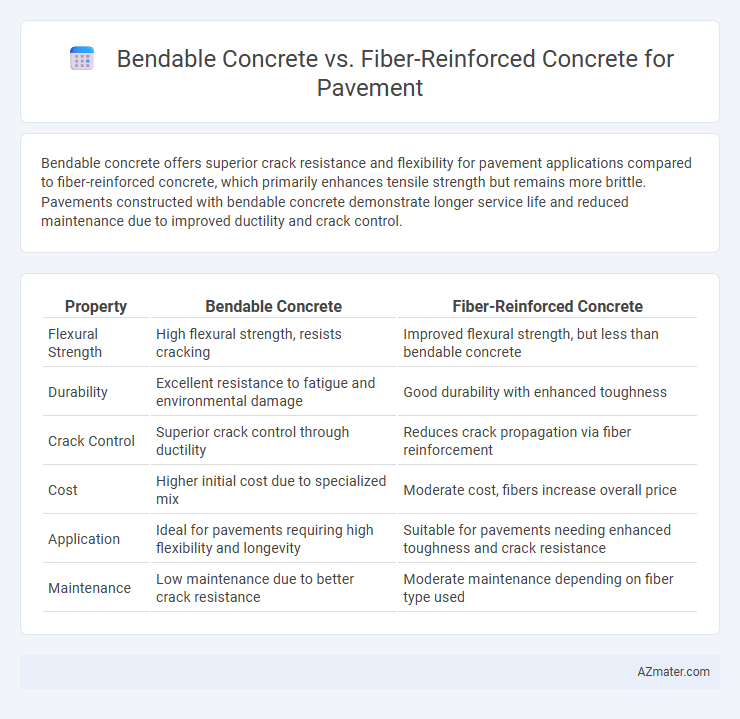Bendable concrete offers superior crack resistance and flexibility for pavement applications compared to fiber-reinforced concrete, which primarily enhances tensile strength but remains more brittle. Pavements constructed with bendable concrete demonstrate longer service life and reduced maintenance due to improved ductility and crack control.
Table of Comparison
| Property | Bendable Concrete | Fiber-Reinforced Concrete |
|---|---|---|
| Flexural Strength | High flexural strength, resists cracking | Improved flexural strength, but less than bendable concrete |
| Durability | Excellent resistance to fatigue and environmental damage | Good durability with enhanced toughness |
| Crack Control | Superior crack control through ductility | Reduces crack propagation via fiber reinforcement |
| Cost | Higher initial cost due to specialized mix | Moderate cost, fibers increase overall price |
| Application | Ideal for pavements requiring high flexibility and longevity | Suitable for pavements needing enhanced toughness and crack resistance |
| Maintenance | Low maintenance due to better crack resistance | Moderate maintenance depending on fiber type used |
Introduction to Advanced Concrete Technologies
Bendable concrete, a type of engineered cementitious composite, offers enhanced ductility and crack resistance through finely distributed fibers, improving pavement durability under dynamic loads. Fiber-reinforced concrete incorporates various fibers like steel, glass, or synthetic materials to increase tensile strength and reduce crack propagation, optimizing pavement performance. Both technologies represent advancements over traditional concrete by addressing brittleness, extending pavement lifespan, and reducing maintenance costs in infrastructure applications.
Defining Bendable Concrete
Bendable concrete, also known as strain-hardening cementitious composite (SHCC), is engineered to exhibit high tensile ductility and crack control, allowing pavements to flex under loads without brittle failure. Unlike fiber-reinforced concrete (FRC), which primarily improves toughness and controls microcracking with dispersed fibers, bendable concrete incorporates fine fibers and optimized mix design to achieve multiple tight cracks and significant strain capacity. This enhanced flexibility makes bendable concrete particularly suitable for pavements requiring long-term durability and resistance to fatigue cracking.
Overview of Fiber-Reinforced Concrete
Fiber-reinforced concrete (FRC) enhances pavement durability through the integration of discrete fibers such as steel, glass, or synthetic materials, which improve tensile strength and crack resistance. This composite material distributes stress more evenly, reduces shrinkage, and controls cracking better than conventional concrete, making it suitable for heavy traffic applications. FRC also offers improved impact resistance and fatigue life, contributing to longer-lasting pavement surfaces compared to traditional bendable concrete.
Mechanical Properties Comparison
Bendable concrete exhibits higher tensile strength and greater ductility compared to fiber-reinforced concrete, enabling it to withstand larger strain before failure, which improves crack resistance in pavement applications. Fiber-reinforced concrete enhances toughness and impact resistance by distributing stress through embedded fibers but generally has lower flexural strength than bendable concrete. The superior flexural performance of bendable concrete reduces crack propagation and maintenance costs, making it more suitable for pavements subjected to dynamic loads and thermal expansions.
Flexural Strength and Durability
Bendable concrete exhibits superior flexural strength due to its engineered microstructure, enabling it to withstand higher tensile stresses and resist cracking under heavy traffic loads on pavements. Fiber-reinforced concrete enhances durability by distributing stresses through embedded fibers, reducing crack propagation and improving resistance to fatigue and freeze-thaw cycles. Comparative studies reveal bendable concrete can achieve flexural strengths up to 10 MPa, while fiber-reinforced concrete typically ranges between 5 to 7 MPa, making bendable concrete more effective for long-lasting pavement applications.
Crack Resistance and Control
Bendable concrete, engineered with enhanced flexibility, provides superior crack resistance by accommodating tensile strains and preventing brittle failure, making it highly effective for pavement applications subjected to heavy traffic loads. Fiber-reinforced concrete incorporates synthetic or steel fibers that bridge cracks, improving crack control and distributing stress more evenly across the pavement surface. Both materials enhance durability, but bendable concrete excels in crack resistance through ductility, while fiber-reinforced concrete offers improved crack control via fiber reinforcement mechanisms.
Installation and Workability Factors
Bendable concrete offers superior flexibility and crack resistance, allowing for easier installation in pavements with variable loads and thermal expansion compared to fiber-reinforced concrete. Fiber-reinforced concrete improves tensile strength and crack control but can increase mixing and placement complexity due to fiber distribution challenges. Workability in bendable concrete is enhanced by its optimized matrix design, reducing the need for specialized equipment during installation, whereas fiber-reinforced concrete often requires careful fiber dosing and advanced mixing techniques to ensure uniform dispersion.
Cost Analysis and Economic Considerations
Bendable concrete offers improved crack resistance and durability compared to fiber-reinforced concrete, potentially reducing long-term maintenance costs despite higher initial material expenses. Fiber-reinforced concrete generally provides a lower upfront cost, making it suitable for budget-sensitive projects, but may require more frequent repairs and associated economic impacts over the pavement lifespan. Life-cycle cost analysis reveals that bendable concrete can be more cost-effective in heavy-traffic pavements due to extended service life and reduced rehabilitation needs.
Environmental Impact and Sustainability
Bendable concrete, known for its high ductility and crack resistance, reduces maintenance frequency and extends pavement lifespan, lowering the environmental footprint through decreased material consumption and reduced repair-related emissions. Fiber-reinforced concrete enhances durability and load distribution, but its environmental impact varies based on fiber type; synthetic fibers may contribute to microplastic pollution, whereas natural fibers offer a more sustainable alternative. Both materials contribute to sustainable pavement solutions by improving performance and longevity, with bendable concrete showing a stronger potential for minimizing lifecycle environmental impacts.
Applications and Suitability for Pavement Projects
Bendable concrete exhibits high tensile strength and flexibility, making it ideal for pavements exposed to heavy traffic loads and extreme temperature variations, reducing cracking and extending service life. Fiber-reinforced concrete enhances impact resistance and controls shrinkage cracks, suitable for pavements requiring improved durability and load distribution in moderate-traffic areas. Both materials improve pavement performance, but bendable concrete is preferred in high-stress environments while fiber-reinforced concrete is cost-effective for general pavement applications.

Infographic: Bendable concrete vs Fiber-reinforced concrete for Pavement
 azmater.com
azmater.com